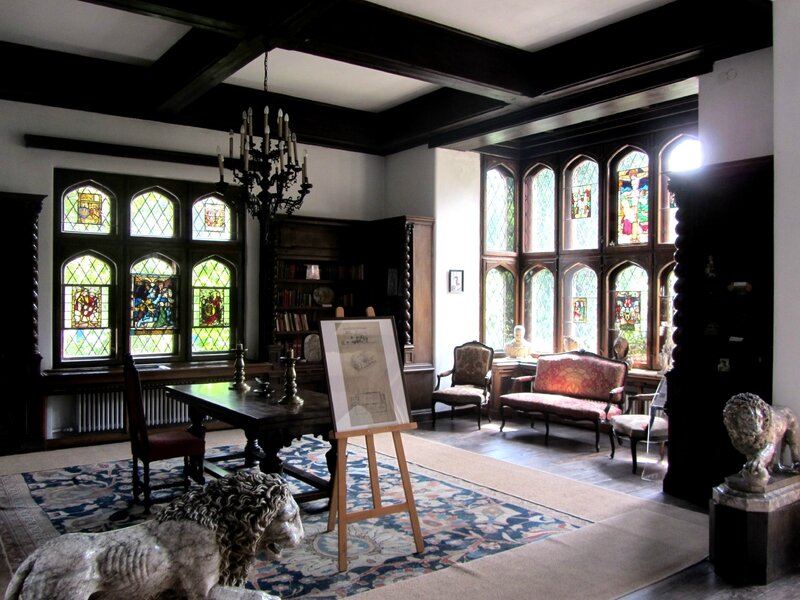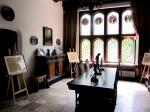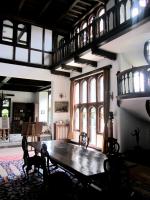Dumitru Furnica-Minovici, his museum and his famous uncles
 (Image source) Dumitru Furnica-Minovici (1897-1982) was born into an influential Aromanian family legendary for their crusade in the name of Romanian medicine. His Brasovian father was a merchant and his mother, Elena, one of the sisters of the famous Minovici brothers.
(Image source) Dumitru Furnica-Minovici (1897-1982) was born into an influential Aromanian family legendary for their crusade in the name of Romanian medicine. His Brasovian father was a merchant and his mother, Elena, one of the sisters of the famous Minovici brothers.
Dumitru had three fascinating uncles: The first, Mina (1857, Braila-1933, Bucuresti), founded the world's first morgue in Bucharest in 1892 (imagine the conversations at dinner!) and created the term "legal medicine" as a way of organising research, teaching and forensics in the Balkan region. His Institute, founded in 1892, was demolished in 1985 by the Ceausescu regime.
The second, Ştefan (1867, Ramnicu Sarat-1935, Pitesti), founded the Analytic Chemistry Department, The General Association of Pharmacists in Romania (1899) and The Romanian Chemistry Academy (1919), whilst the third uncle (my favourite), Nicolae (1868-1941), founded the first ambulance service in 1906 with his own capital (although this was the responsibility of the authorities) and established Romania's first hospital with a permanent emergency service - the second in Europe after Moscow. He was also mayor of Baneasa in the bygone days when mayors were decent, cultured and had love and respect for their country.
Nicolae was a forensic scientist (like his brother Mina) and criminologist, serving as head of the country's anthropometric service. He is known, says Wikipedia, for his studies investigating connections between tattooing and criminal behaviour, as well as his research on hanging and its physiological effects on the human body. His research on hanging included - wait for it - multiple hanging experiments performed on himself, each lasting for a period of approximately five seconds. Aoleu! I bet Nicolae was Dumitru's favourite uncle for that alone!!
 (Photo source: Muzeul Nicolae Minovici, 1905) Nicolae was a remarkable researcher in the field of medicine, but also had an insatiable passion for art. In 1905, he built a house (architect - Cristofi Cerchez) in Brancovanesc-style to exhibit his collection of modern and folk art. He died from cancer of the vocal chords in 1941 and, a bachelor, bequeathed his estate which included money, villa and collections, to the city of Bucharest. It became Romania's first ethnographical and national folk art museum, and was also known as Casa cu Clopotei (The House of Bells) due to the forty bells that tinkled ethereally from its balcony.
(Photo source: Muzeul Nicolae Minovici, 1905) Nicolae was a remarkable researcher in the field of medicine, but also had an insatiable passion for art. In 1905, he built a house (architect - Cristofi Cerchez) in Brancovanesc-style to exhibit his collection of modern and folk art. He died from cancer of the vocal chords in 1941 and, a bachelor, bequeathed his estate which included money, villa and collections, to the city of Bucharest. It became Romania's first ethnographical and national folk art museum, and was also known as Casa cu Clopotei (The House of Bells) due to the forty bells that tinkled ethereally from its balcony.
In 2002, the museum was closed for renovation and its treasures transported elsewhere. During my visit to Dumitru's museum, I asked the knowledgeable guide where they had been taken, but she couldn't tell me. One thing is for sure though: they have not been lent to any other museum in Romania. Throughout its existance, the museum as well as the surrounding park and orchard suffered a wide range of tragic degradation, from the loss of parts of its collection to periods when it was closed owing to the political regime, structural damage and general neglect. After a couple of false starts over the last twelve years since its closure, work began in earnest two weeks ago. The villa stands stark and neglected as workmen beaver away. I pray that Nicolae's villa will finally be restored to its former glory and all its collections he loved so dearly returned safe and sound before too long. For more on the Nicolae Minovici Museum of Folk Art, please see HERE. (Just found more info on this - and it is worrying. Please scroll down to the bottom of this blog to the paragraph beginning ***)
Now you have some background in terms of the atmosphere and influence surrounding Dumitru as he grew up, let's get back to him.
From a young age, Dumitru seemed destined to follow in the footsteps of his uncle Nicolae. When he was eight, rather than opting to buy a kite, he chose a copy of a portrait of Lorenzo de Medici, the famous Mecena of the Florentine Renaissance! It was a gesture of a great future collector to be sure. After finishing military training, he left for France to study, supported by Nicolae, graduated in 1924 and returned to Romania to make his fortune in the oil business.
 His beautiful house on land left to him by his uncle Nicolae, next door to the latter's villa, which was to become Muzeul de Arta Veche Apuseana "Ing. Dumitru Furnica-Minovici" (The Museum of Ancient Western Art or The Museum of Feudal Art, depending which guide you read) was built 1941-2 at the exorbitant sum of 7,032,182 lei-aur (the money of 1942) around his vast collection of medieval art by architect Enzo Canella following Dumitru's own plans. This red-brick XVc English Gothic Tudor-style jewel is superb both structurally and aesthetically.
His beautiful house on land left to him by his uncle Nicolae, next door to the latter's villa, which was to become Muzeul de Arta Veche Apuseana "Ing. Dumitru Furnica-Minovici" (The Museum of Ancient Western Art or The Museum of Feudal Art, depending which guide you read) was built 1941-2 at the exorbitant sum of 7,032,182 lei-aur (the money of 1942) around his vast collection of medieval art by architect Enzo Canella following Dumitru's own plans. This red-brick XVc English Gothic Tudor-style jewel is superb both structurally and aesthetically.
Graduate of the Universities of Strasbourg and Toulouse and director of Miner Credit with a residence in Vienna, Dumitru assembled his superb collection of masterpieces during the course of his lifetime and whilst he was filling his home with valuable objects of art, his wife, Lady Ligia (died 2004 in Paris), was busy making it homely and welcoming. The atmosphere she created is still very much evident today. For more on Lady Ligia, please see HERE.
In 1945, the house was 'donated' (under pressure by the communist regime) to the Romanian Academy, as 'requested' by the then-prime minister, Petru Groza. The Minovici Foundation explains, 'The donation was made under the transfer of power to a Stalinist movement in an effort to avoid the devastation and confiscation by the new form of Government, but with firm clauses and conditions, most of them were violated by the current democratic government and its de facto owner, The Romanian Academy.'
The Minovici Foundation continues: 'For two centuries, this family of doctors, scientists, chemists, engineers and entrepreneurs built, maintained and contributed an exquisite cultural, educational, medical and social legacy to Romania and its citizens. This legacy battled and continued to fight some of the worst social conditions: war, famine and forced disinheritance by an oppressive regime, and, more recently, carelessness and obliteration of institutions and organisations that benefited for years from this inheritance.'
 (Photo left - The entrance hall) Built on two adjoining properties, the houses/museums of Nicolae and Dumitru Minovici functioned as one until 1982 (when Dumitru Furnica-Minovici died. Incidentally, he and Lady Ligia were both buried at Bellu). The tour for visitors included not only the houses themselves but the park and orchard too.
(Photo left - The entrance hall) Built on two adjoining properties, the houses/museums of Nicolae and Dumitru Minovici functioned as one until 1982 (when Dumitru Furnica-Minovici died. Incidentally, he and Lady Ligia were both buried at Bellu). The tour for visitors included not only the houses themselves but the park and orchard too.
In this masterpiece of the Tudor and Plantagenet periods with its many windows that flood the house with light throughout the day, Flemish, French Gothic and Italian elements are perfectly intertwined with the surrounding once-beautiful Italianate garden. A great shame that the building of a hideous block was permitted to spring up right next door and far too close, that has spoilt what must have been a wonderfully serene and peaceful park not so long ago.
The three-storey house itself, a true gem, begins with a long entrance hall filled with hunting trophies from Austria, Germany and Switzerland, old weapon pieces (a crossbow, old guns and rifles), medieval armour and stunning engravings from the XVIIc adorning the walls that take your breath away. Stained-glass windows align the right-hand wall bathing the hall in a gentle, warm and somewhat mysterious light.
 (Photo left - the library) The museum, open to the public free of charge, is made up of three exquisite rooms downstairs: the vast living-room with its monumental Italian renaissance chimney, Chippendale chairs and marvellous French Gothic serpentine staircase (see left); the cosy, Neo-classical library with Cosimo de Medici’s portrait painted by Bronzino, nut wood furniture and Aubusson chairs and the Italian dining room complete with beautifully sculpted classical Austrian wooden doors. Entirely decorated with the most stunning European pieces, your jaw will spend most of its time on the floor:
(Photo left - the library) The museum, open to the public free of charge, is made up of three exquisite rooms downstairs: the vast living-room with its monumental Italian renaissance chimney, Chippendale chairs and marvellous French Gothic serpentine staircase (see left); the cosy, Neo-classical library with Cosimo de Medici’s portrait painted by Bronzino, nut wood furniture and Aubusson chairs and the Italian dining room complete with beautifully sculpted classical Austrian wooden doors. Entirely decorated with the most stunning European pieces, your jaw will spend most of its time on the floor:  German and Austrian stained-glass; Flemish tapestries; Toscan renaissance, Louis XIII, Louis XV and Elizabethan furniture; works by Italian, Flemish and German painters; rare books; pottery from Meissen and Delft (XVII-XVIIIc) and XVIc etchings.... endless gasps, continual sighs - I was awe-struck from the moment I entered this other world, to the moment I stepped back out into the front garden. Although I was prepared for beauty, so much of it in such a warm and homely atmosphere clean rendered me speechless (that's quite a feat). The custodian, a formidable guide, must have taken me for a mutant goldfish as I opened and closed my mouth unable to find the words (in any language) to express such enchanted wonder.
German and Austrian stained-glass; Flemish tapestries; Toscan renaissance, Louis XIII, Louis XV and Elizabethan furniture; works by Italian, Flemish and German painters; rare books; pottery from Meissen and Delft (XVII-XVIIIc) and XVIc etchings.... endless gasps, continual sighs - I was awe-struck from the moment I entered this other world, to the moment I stepped back out into the front garden. Although I was prepared for beauty, so much of it in such a warm and homely atmosphere clean rendered me speechless (that's quite a feat). The custodian, a formidable guide, must have taken me for a mutant goldfish as I opened and closed my mouth unable to find the words (in any language) to express such enchanted wonder.
 She explained that the house had not been renovated, but needs to be in the foreseeable future. Due to a problem with the roof some time ago (now resolved), the wall of the enormous chimney suffered damage - traces are still visible as damp stains and peeling - as did areas on the upper floors. The Romanian Academy still partially owns the property as far as I know, and the upper floors are used for administration. They cannot be visited, though I was dying to climb the Gothic serpentine staircase.
She explained that the house had not been renovated, but needs to be in the foreseeable future. Due to a problem with the roof some time ago (now resolved), the wall of the enormous chimney suffered damage - traces are still visible as damp stains and peeling - as did areas on the upper floors. The Romanian Academy still partially owns the property as far as I know, and the upper floors are used for administration. They cannot be visited, though I was dying to climb the Gothic serpentine staircase.
 Ligia and Dumitru Minovici’s passion for beauty takes us back in time to an old Bucharest when things were oh, so different. Here, beside Uncle Nicolae's 'Casa cu Clopotei', exists only art, history and pure perfection.
Ligia and Dumitru Minovici’s passion for beauty takes us back in time to an old Bucharest when things were oh, so different. Here, beside Uncle Nicolae's 'Casa cu Clopotei', exists only art, history and pure perfection.
Muzeul de Arta Veche Apuseana "Ing. Dumitru Furnica-Minovici": str. Dr. Nicolae Minovici nr. 3, Sector 1, Bucuresti - Phone: +4021.665.73.34 // Bus stop: Gara Baneasa
Photos by Sarah In Romania when not otherwise indicated. Please ask before borrowing or hyperlink back to this post. Thank you!

/https%3A%2F%2Fstorage.canalblog.com%2F03%2F12%2F353913%2F41915630_o.jpg)
/https%3A%2F%2Fstorage.canalblog.com%2F15%2F06%2F353913%2F41915331_o.jpg)
/https%3A%2F%2Fstorage.canalblog.com%2F03%2F68%2F353913%2F41914713_o.jpg)
/https%3A%2F%2Fstorage.canalblog.com%2F22%2F12%2F353913%2F29890995_o.jpg)
/https%3A%2F%2Fstorage.canalblog.com%2F68%2F41%2F353913%2F29890862_o.jpg)






/https%3A%2F%2Fstorage.canalblog.com%2F08%2F12%2F353913%2F116988178_o.jpg)
/https%3A%2F%2Fstorage.canalblog.com%2F59%2F38%2F353913%2F115811794_o.jpg)
/https%3A%2F%2Fstorage.canalblog.com%2F00%2F54%2F353913%2F113969303_o.jpg)
/http%3A%2F%2Fp8.storage.canalblog.com%2F81%2F17%2F353913%2F59684501_p.jpg)